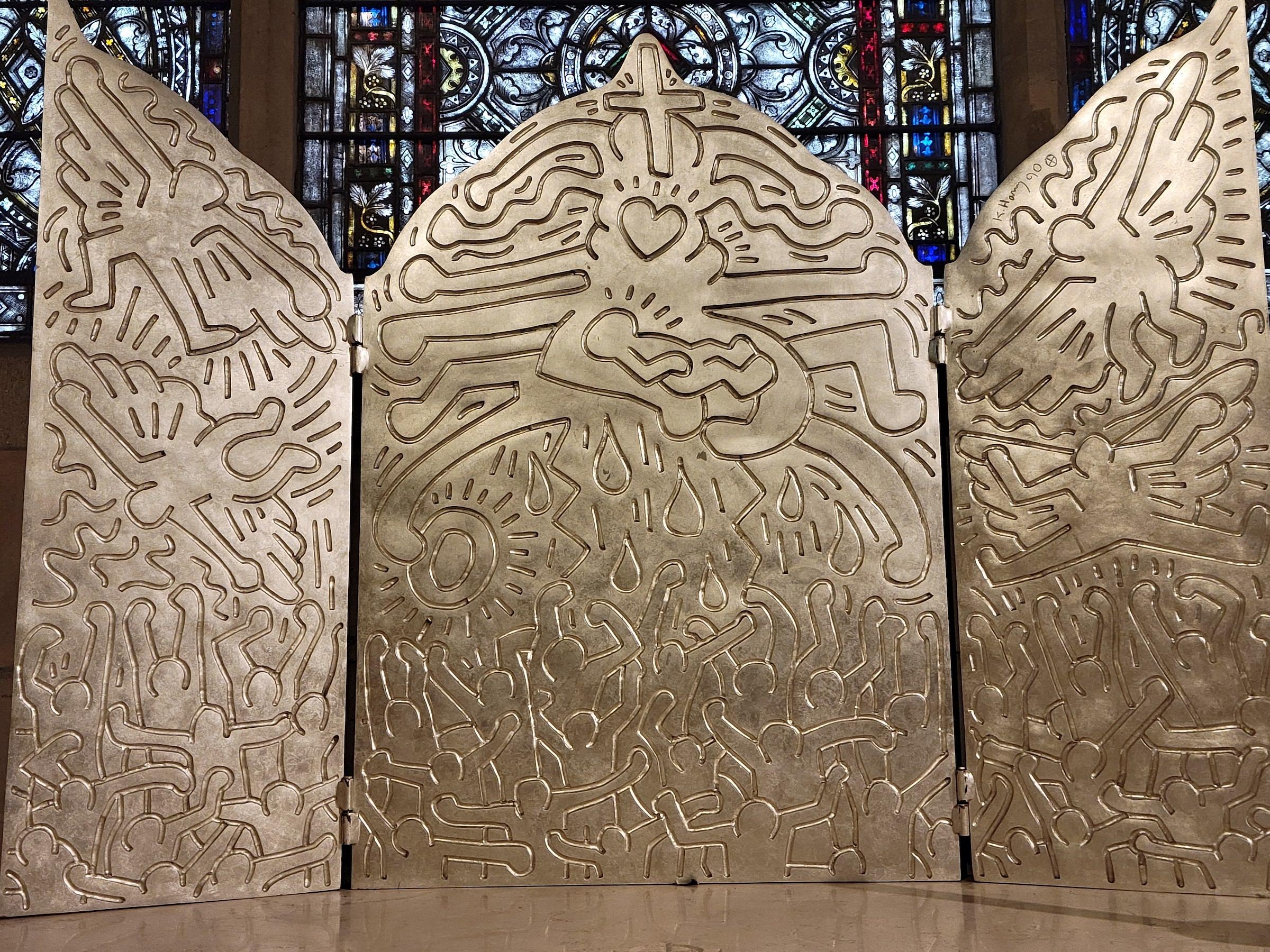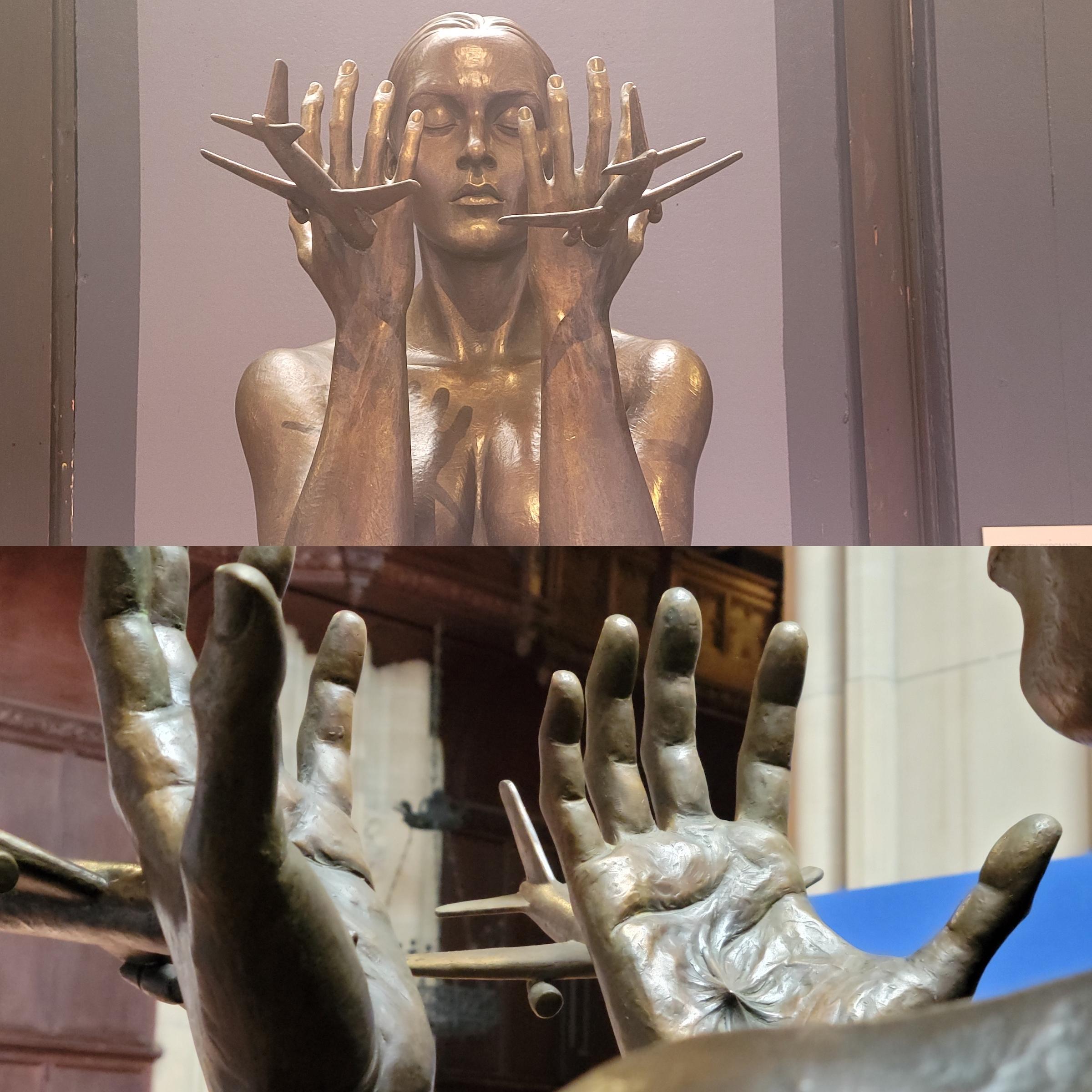The Cathedral Church of St. John the Divine
1047 Amsterdam Ave. at 112th St.
New York, N.Y.
Collection on view — ongoing
Does this Madonna and Holy Infant surprise you?
Her arms and hands are in the orans gesture of supplication and prayer but turned outward, signifying “Hands up, don’t shoot!” A golden cross, marking the crosshairs of a gun frames the Christ child, with a crown of thorns encircling his heart. This Baby Jesus shows he has no weapons.

For centuries, the Church has been a seat of power, with art that defined history across the globe. “Who controls those narratives is a social, political question,” said the Very Reverend Dr. James A. Kowalski. He served as the ninth dean of the Cathedral Church of St. John the Divine in New York City, where Mark Doox’s “Our Lady Mother of Ferguson” is on display.
I visited the church to learn more about what it aims to say and do with the art it curates.
Christ was from the Middle East, but most Western art depicts him as “bearing no resemblance to anybody who would have been around Jesus in that first century,” said Kowalski.
Realistically, the Mother of Christ was also most likely not a WASP (White Anglo-Saxon Protestant), a term often associated with Episcopalians. With roots in the Church of England, the Episcopalian Church is a member of the Anglican Communion. Its website states, “We are denominational descendants of — and partners with — the Church of England and the Scottish Episcopal Church.”
While valuing history and traditions, the reverend warned against dominant positions, which overlook the insights of other perspectives.
“Are we destined to keep parking in this place of Caucasian dominance?” asked Kowalski. “No. With inclusivity and comprehensiveness, which are supposedly tenets of Anglicanism, the more you draw people into the larger circle, the more you will get closer to the truth and see the larger reality.”
The Episcopalian Church is known for intellectually progressive stances such as ordaining women, embracing LGBTQ rights, and viewing reproductive health as medical healthcare. It encourages experiential as opposed to more didactic, doctrinal spiritual beliefs. And this cathedral’s art is distinctive.
Janet Abraham, a docent who gives tours at St. John’s, emphasized the art supports the cathedral’s mission to be a house of prayer for all people, not just Episcopalians and not just Christians.
Spanning the length of two football fields, with its cornerstone laid in 1892, the church’s objects and artwork extend across time and geography. It includes a stone from the prison cell where Joan of Arc slept prior to her execution in 1431 as well as modern and contemporary art, which stoke political debate in our evolving world.
Kowalski defined art as something to “educate people’s imaginations to clarify our understanding of what is and to imagine what could be, the critique it offers, the polemic that it may try to even force on people or encourage people to enter into a dialogue, many times about power.”

“Christa” depicts Christ as a bare-breasted, nude woman nailed to a cross. Created by Edwina Sandys, Winston Churchill’s granddaughter, the sculpture represents the suffering and oppression of women. When first displayed at the church in 1984, it created a heated controversy, and the suffragan bishop of the diocese ordered it removed. As the dean in 2016, Kowalski brought back the figure as part of an exhibition on symbolism and the divine that many faiths believe exists inside us all.
The wall text describes how the Right Reverend Paul Moore, Jr., who was the Episcopalian Bishop of New York at the time of the show, said he was shocked upon first seeing the female Christ. Moore noted for years he worshipped before male Christ figures and referred to God as He. The reverend said although he was not prepared for the image, “‘it made me think.’”
When AIDS was a national scourge, discrimination against LGBTQ communities flared. In 1995, AIDS became the leading cause of death of Americans aged 25 to 44. Abraham stated that St. John’s reached out early to support victims of the disease. The HIV virus had become a highly political issue, where people needed to fight discrimination to demand government support for AIDS legislation and funding.

In his final days before dying of AIDS in 1990, artist Keith Haring drew in slabs of clay the triptych of “The Life of Christ.” It was his last work of art. After he died the tablets were cast in bronze, then covered in white gold. Nine were made, with the first one placed at St. John’s. His graffiti tag of the “Radiant Baby,” a child crawling with rays of energy, is flipped on its back to depict the Christ child, bringing joy into the world.
In explaining the openness integral to his faith, Kowalski said, “How could we have been so wrong about race, women, human sexuality? The answer is easy because we don’t know what we don’t know.”
Abraham stated one central mission of the church is to work toward building a place where everyone lives in harmony, the establishment of New Jerusalem.

One contemporary piece “September 11th: Memorial” reminds us how much further we have to go to reach that state.
Meredith Bergmann’s sculpture is made of bronze, steel, glass, and a reliquary-like containment of rubble from the World Trade Center. The figure’s two arms are raised in parallel form, resembling the Twin Towers. The tips of the planes crash into the her hands held in an orans prayer position, forming stigmata, the marks of Christ crucified. Abraham interpreted this as representing protection and the creation of a space and “room for love.” Taking another perspective, I imagined that one day those who died in the terrorist attack may be seen as having sacrificed their lives to build greater understanding in the world.
This article began with a discussion about religious art with one of my friends, Allison Gushée Molkenthin, a practicing Episcopalian. Her father served as the dean of Christ Church Cathedral in Hartford, Connecticut. She believes the church helped shape her mindset of inviting strangers and ideas to her table. And I thought of how she often creates spaces of acceptance, where people and their conversations belong.
I’m not asserting that art and friendships simplistically could have averted the horrific murders of 9/11. But art is about power that can create narratives, which challenge and influence us. And maybe one painting, sculpture and triptych at a time, we can incrementally open and change the world.
Where I’m going next: “Ruth Asawa Through Line” at the Whitney Museum of American Art.






